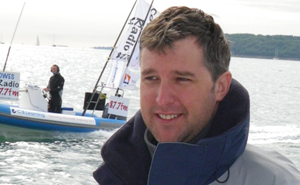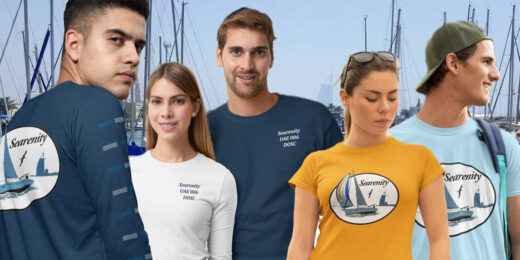Interview with Pilote Media CEO – David Fuller featured on Melges24.com
Sponsorship Expert David Fuller of Pilote Media On Securing A Sponsor For Your Team
Most Melges 24 owners will have at some time considered sponsorship as a potential means of offsetting the cost of campaigning their boat on the regatta circuit. Indeed on the US and European circuits, hulls and sails displaying sponsors decals are a familiar site these days.
Bagging yourself a sponsor is not a simple matter and requires a professional approach. What is the best way to attract a sponsor in these post credit crunch times? Are there still businesses out there worth approaching with a proposal? How do you position your team as a viable sponsorship option?
To try to find answers to these and other questions we sat down with someone who specialises in yacht sponsorship – David Fuller, founder of Pilote Media, a niche publisher and sports marketing consultancy that specialises in the business of yacht racing and the contributing editor at the website www.yachtsponsorship.com .
IM24CA: Given the difficult global economic situation are there still any businesses out there that are interested in sponsoring yacht racing?
DF: Yes. For some, the global economic situation is an opportunity to re-evaluate sponsorships and some companies are looking to more ‘niche’ sports where there might be some relative bargains to be had. It needs to be a business-based sponsorship though, with real deliverables. Companies can’t be seen to be spending money on going sailing while at the same time making people redundant.
IM24CA: What would you say potential sponsors find attractive about yacht racing?
DF: Yacht Racing has many attractive attributes, some unique. For example the team element – racing a Melges 24 with a four person crew is one of the only sports where the whole team is contributing at the same time. Not like a basketball team where one or two players are involved or football where eight people are ‘not doing anything’.
There are some obvious environmental advantages of sailing over Motorsport for example and overall it can be relatively cheap compared to other sports.
IM24CA: What type of businesses – large or small – are most likely to respond positively to an approach to sponsor an individual Melges 24 campaign?
DF: Rather than think about the size of a business, it is better to think about what their goals might be and who they are trying to communicate with. Companies that operate in the same markets that you are competing in are probably the best place to start. Not only are their customers being exposed to the sponsorship, but they can also involve employees and partners.
IM24CA: What is the best way to make initial contact with a business to open a dialogue about sponsorship? In a large organisation which department would be the best starting point?
DF: It is different for every company. Very large companies have dedicated sponsorship teams and if a business is already sponsoring sports or community activity they will talk about on their website. Marketing or communications (PR) is a good place to start, but often it is more productive to approach the CEO directly.
IM24CA: Is mass mailing of a proposal to hundreds of companies a good idea or does a more targeted approach work better? How about cold calling by phone?
DF: Sometimes you might get lucky sending out a mass proposal, but it’s like getting a job. You will do better if you take some time to understand the company. If you don’t know who they are or what they do, then you can’t know how you can help them. Do some research and find out where their offices are. Understand their products or services. Then you can cold call.
IM24CA: What are the key sections of a sponsorship proposal document?
DF: The key section of a sponsorship proposal is the outline of benefits to the sponsor. What are you offering in return for the money? What’s included – what’s not? If you are in a fleet – why are you more sponsorable then the next team? Companies will vary as to the amount of detail they need depending on their sophistication.
IM24CA: What is in it for the sponsor? What are the typical reasons that a business might be interested in sponsoring a yacht race team? What are some good ways of measuring the positive effect of sponsorship?
DF: This depends on what they are trying to achieve. The phrase ‘return on investment’ (ROI) is used a lot, but there is another phrase that is being used for sponsorship which is Return on Objectives (ROO). A company might have an objective to reward their high-performing sales team, they might have an objective to enter a new market or launch a new product. Most companies are looking for awareness and exposure but some are trying to position themselves more accurately and all are hoping that it will lead to more sales.
Measurement is difficult and it is often expensive to qualify sponsorship value. Traditionally, sponsorship has been measured using a model of equivalent value – for example if a photo appears in a magazine with the sponsor’s logo and the ad rate for a page in that magazine is £2000, then the equivalent value is £2000. This is a pretty flawed model and one of the reasons sponsorship gets a bad name sometimes.
Luckily, in the new world, we have digital forms of media. It is easier to count a webpage visit or a click or a You Tube view and in some cases you can track that back to sales. Setting clear objectives makes it easier to measure if you have achieved them.
IM24CA: What other sports can we learn lessons from?
DF: There are best practices in all sports. How you get the most out of a sponsorship depends on the audience you are trying to reach and your budget. There are some great examples in sailing.
Puma is doing an amazing job at the moment with their Volvo Ocean Race campaign and a lot of it can be done relatively cheaply. You aren’t going to build a hospitality unit out of shipping containers, but you can make sure you have a good website with some video and ways of communicating. Some of the extreme sports do a great job of using new media like You Tube, Facebook and Twitter to engage with their fans and communicate their sponsor’s message to a wider audience.
IM24CA: What can class associations and sailing’s governing bodies do to help make yacht racing more attractive to potential sponsors?
DF: This is not easy. Every class has its own rules and its own culture. Not everyone will want to accept sponsorship. If a class makes a decision to allow sponsorship then it has to be prepared to work to help those sponsors achieve their goals. Class associations and governing bodies need to be able to show that they have the skills to compete for a share of the sponsorship money out there. Do you have dedicated press? Do you have people who can explain sailing to a non-expert audience? Do you have an up to date website? Do you have the infrastructure to entertain guests before, during and after an event? How do spectators watch? An event needs to show that all these things are in place and the more it can be a fixed menu of options, the better.
IM24CA: What three key pieces of advice do you have for someone starting to look for a potential sponsor for their Melges 24 campaign?
DF: Be Prepared.
This is a commercial transaction. Know the product you are selling. Understand your numbers. Understand what benefits you can provide. Know what makes you different from the other teams – do you have a story? If you don’t have a website, get one. Create a sponsorship pack. For some key companies it might be worthwhile to get your presentation bound. It is amazing how a professionally printed, bound document can make you look the part.
Start local.
I heard a story the other day of a team whose base was located over the road from a large corporate headquarters. The team manager bumped into someone in the car park and they got talking. When asked what they did, one guy said – we run a race team and the other guy, the CEO of the company said, “if only we had known – we’ve just sponsored another race team”. They had been neighbours for years. Network.
Think about Activation.
Sponsorship is only half the story. Good sponsorships are accompanied by activity that promotes the relationship in the rest of the company’s communications. Typically, activation costs about the same amount on top of the sponsorship amount. It might take the form of banners at the events, it might be advertising programmes or local papers, it might be You Tube videos or appearances by the team at company events. It might be photo opportunities or tie-ins with other sponsored properties. You don’t have to be an expert at activation, but being creative with these ideas can show how sailing can be more than just a logo on a boat – it can be a platform for many messages to many audiences.
First published at : http://www.melges24.com/?p=news/&id=1602


